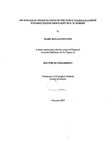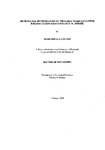Microfaunal investigation of the Early Toarcian (Lower Jurassic) extinction event in N.W. Europe
| dc.contributor.author | Hylton, Mark Donald | |
| dc.contributor.other | Faculty of Science and Engineering | en_US |
| dc.date.accessioned | 2011-09-22T10:47:36Z | |
| dc.date.accessioned | 2013-10-04T11:00:42Z | |
| dc.date.available | 2011-09-22T10:47:36Z | |
| dc.date.available | 2013-10-04T11:00:42Z | |
| dc.date.issued | 2000 | |
| dc.identifier | Not available | en_US |
| dc.identifier.uri | http://hdl.handle.net/10026.1/587 | |
| dc.description | Access to the full-text thesis is no longer available at the author's request, due to 3rd party copyright restrictions. Access removed on 28.11.2016 by CS (TIS). | |
| dc.description | Metadata merged with duplicate record (http://hdl.handle.net/10026.1/2027) on 20.12.2016 by CS (TIS). | |
| dc.description.abstract |
The Early Jurassic was a time of rapidly rising sea-level associated with the extensive spread of anoxic bottom waters. Sea-level rise across the Pliensbachian - Toarcian boundary culminated in the falciferum Zone of the Toarcian and is one of the best authenticated eustatic events in the Jurassic. This major transgressive pulse was marked by deepw ater marine sequencesa nd was associatedw ith the deposition of organic-rich shales. The development of anoxia coincides with a notable period of mass extinction of the marine fauna. High resolution sampling and study of the microfaunast hrough sequencesin N. W. Europe confirm that benthic foraminiferal. faunas were similarly affected by an early Toarcianfalciferum Zone event. Samples were analysed from Pliensbachian - Toarcian mudstone,c lay and shale sequenceso f the south Dorset Coast,t he Midlands, the Yorkshire Coast, southern France and southwest Germany. The sections studied show distinct changes in assemblagesa cross the Pliensbachian - Toarcian boundary and in the basal zones of the Toarcian. Evidence for a foraminiferal extinction event in the Pliensbachian - Toarcian includes the elimination of the important Lower Jurassic Lingulina tenera, Frondicularia terquem! and Marginulina prima plexus groups, initiating a significant period of turnover of the microfauna. The foraminiferal extinction event recorded in the Lower Toarcian sections of north west Europe is only significant at species level. No extinctions at the family-level occurred. A marked changea lso occurred in the charactero f associatedn odosariid assemblagest:h e uniserial forms of Nodosaria, Frondicularia and Lingulina, dominating the Pliensbachian assemblagesw, ere largely replacedb y coiled Lenticulina in the early Toarcian. A reduction in test size and a decline in species diversity, compared with Hettangian to Sinemurian foraminiferal assemblagesr,e flect the developmento f low oxygen conditions followed by a subsequenrte newal of the microfauna in the Middle Toarcian. The foraminiferal data show no evidence of progressive displacement of older by younger faunas. Instead certain species only expanded their populations and diversity significantly after the extinction of similar niche-occupying species. The Pliensbachian - Toarcian (Lower Jurassic) sediments of the north Yorkshire coast contain highly organic-rich shales where the sequence stratigraphic significance is somewhat obscure. Benthic foraminiferal species distribution (as a function of organic flux and oxygenation) allowed palaeobathymetry to be determined on quantitative assemblage characteristics. In parallel with this methodology, a suite of trace elements (including Mn, Ca, Fe, and Al) have been analysed following nitric and hydrofluoric acid digestion. Maxima of Ca and Mn occur at the base of the falcifierum Subzone (falcifierum Zone). It is suggested that these maxima are an artefact of condensation of carbonate fossiliferous material due to sediment starvation and correspond to published estimates of a maximum flooding surface. Interpretations of the benthic foraminiferal assemblages surrounding this event provide further support for a transgressive event -associated with the development of low oxygen conditions and the deposition of organic-rich shales. Additional Lower Jurassic,H ettangiant o lower Pliensbachian,s equencesw ere investigated for the purposes of establishing their foraminiferal correlation potential as candidate Global Stratotype Sections and Points for the basal Sinemurian and basal Pliensbachian. | en_US |
| dc.language.iso | en | en_US |
| dc.publisher | University of Plymouth | en_US |
| dc.title | Microfaunal investigation of the Early Toarcian (Lower Jurassic) extinction event in N.W. Europe | en_US |
| dc.type | Thesis | |
| plymouth.version | Full version | |
| dc.identifier.doi | http://dx.doi.org/10.24382/3381 |
Files in this item
This item appears in the following Collection(s)
-
01 Research Theses Main Collection
Research Theses Main



